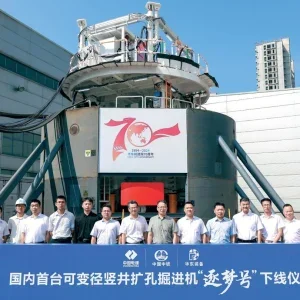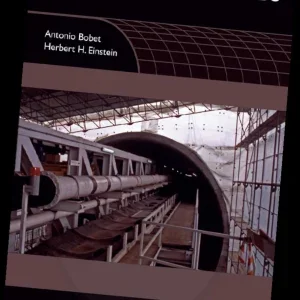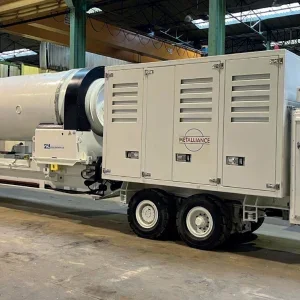Recently we were asked to propose a suitable method for constructing 19 foundations, each 7.5m deep by 3.5m diameter, designed to support a building 20m wide by 36.8m high by 39m long. The building will be erected around an existing reinforced concrete storage structure, currently surrounded by sensitive buildings and installations.
Access to each foundation position is restricted and all construction activities will be confined to a corridor 3.2m wide by 6.5m high, accurately aligned around the storage structure.
By carefully considering and satisfying the onerous and stringent working practices imposed by the client, the authors developed an innovative technique for constructing the foundations based on the use of well proven equipment, established shaft sinking practices and personal experience. It has yet to be trialled.
The technique is ideally suited to confined and/or hazardous situations where man entry below ground may be restricted. In extreme conditions the equipment can be designed for remote operation with minimal surface attendance by operatives.
Ground conditions
Each foundation is required to penetrate 6.5m of made-ground containing cobbles and debris, and the underlying fluvial glacial deposits. The water table is 8m-12m below ground level and there is a possibility of surface water ingress – which may be contaminated.
The made-ground is gravelly with cobbles near the surface, becoming silty towards its base, where a bed of rounded cobbles was encountered overlying glacial deposits. Standard Penetration Test (SPT) values in the near surface made-ground were typically 7 to 300, reflecting the gravel and cobble content and a degree of compaction. SPT values towards the base were in the range 5 to 26.
Clearly the method of excavation must be capable of remote operation in dense made-ground containing cobbles, possibly with contaminated ground water inflow.
The equipment
Figure 1 shows a simplified plan of the foundation positions adjacent to one side of the storage structure with the access routes and working corridor. Similar arrangements will be required to access the foundations adjacent to the remaining three sides.
Figures 2 and 3 show the equipment during excavation and segment erection cycles respectively.
The driving force behind the equipment configuration was the client’s reluctance to permit the use of free-standing equipment, which could either fall or strike critical equipment. This ruled out cranes, 360° excavators and similarly configured equipment, even if their principal movements were physically restrained.
Access track
The access track, with its shear keys into the underlying ground, is essential to guide the equipment along the access corridor to each foundation position. Ideally it should be straight, if that is not possible curves should be of large radius with the surface profile adjusted to reflect equipment turning requirements.
Access track construction must commence outside the sensitive area. Hand techniques should be used with lightweight shutters and box outs for the foundation positions. Ideally, the concrete should be pumped from outside the sensitive area through a pumpline rigidly attached to a previously constructed access track.
Excavation/construction unit
The unit comprises a central tower supported on two powered tracked bogies with independent steerage. One bogie carries a diesel hydraulic power pack, the other an electro hydraulic power pack (to NCB Underground Safety Standards). A narrow gauge railway services the unit at each end with overhead runway beams linking into the tower.
Foundation construction is carried out inside the tower confines in a carefully controlled manner (Figures 2 and 3). In this example a hydraulically powered telescopic pole grab is shown suspended from a traversing unit which gives full coverage of the foundation plan area, permitting the grab unit to travel to the discharge/loading point along one of the overhead runway beams. Segments are individually offloaded from the segment wagon, using a grab lifting attachment, and travelled to their erection positions.
The two sides of the tower together with the discharge/loading points are fully clad to prevent the grab, materials, etc. striking adjacent sensitive equipment. Similarly the tower roof, and to a lesser extent the tower ends, can be clad to improve housekeeping and make activities less weather sensitive. Cladding will add weight to the structure and could be used to aid stability.
Additional stability will be provided by independently operated and mechanically adjustable outriggers.
Purpose designed lifting points and mountings can be attached to the tower structure to suit a particular application; in this example a hydraulically powered caisson thrust ring is shown.
A protected operating position is provided on each bogie with excellent visibility into the foundation and the two discharge/loading points. Sensors must be positioned at strategic locations to monitor for the presence of hazardous substances, gases, etc. with their concentrations displayed in front of the operator, and the appropriate audible and visual warnings given if occupational exposure limits are reached.
The tower unit has been designed to telescope vertically during transportation permitting it to travel beneath highway bridges on a low loader. This also greatly simplifies site erection and commissioning.
For this site a 610mm narrow gauge railway was chosen to service the excavation/construction unit. Clearly alternative suitably guided systems could be used.
Foundation construction
Caisson sinking techniques were chosen to construct each foundation carcass for the following principal reasons:
Using the onboard diesel hydraulic power pack the excavation/construction unit is driven off the low loader, to the purpose designed access track and carefully advanced to the first foundation position. After extending the tower to its operating height, caisson construction commences.
The grab will excavate the caisson collar discharging excavated material into rail mounted wagons at either end of the tower. Cutting edge/choker ring segments will be offloaded from a flat wagon, using a purpose designed lifting attachment on the grab, and erected to suit requirements. At this stage it is accepted that operatives may have to enter the excavation area wearing personal protective equipment, but their duties would be confined to levelling, packing, measuring, erecting and bolting segments. The remaining collar rings will be similarly erected, the bentonite annulus formed and the collar concreted.
Caisson sinking will then commence maintaining a fully buried cutting edge at all times. If cobbles or similar obstructions are encountered they will be removed using either an impact hammer, or transverse cutting unit, mounted on the grab attachment.
Careful use of the hydraulically powered thrust ring will aid caisson steerage and sinking.
When the founding level has been reached the bentonite annulus will be grouted using pre-installed grout pipes or grout lances inserted down the bentonite annulus, and the caisson floor concreted with pumped or grab placed concrete.
Reinforcement, etc. will be transported to the tower, fabricated into full cages, lowered into position and the caisson concreted with pump placed concrete.
Careful profiling of the foundation surface will allow the equipment to travel to the next foundation position.
Safety aspects
The technique developed satisfied the client’s onerous and stringent working requirements associated with working and constructing in a confined and hazardous environment.
Principal safety requirements met and satisfied include:
Conclusions
The technique developed offers a system that can be purpose designed to suit a particular application in a confined and/or hazardous environment. Although here relating to foundation constructing, the system could easily be used for shaft sinking in confined spaces. It can be adapted to suit a variety of plan shapes, sizes and configurations, including a continuous structure and is not confined to a caisson sinking approach.
Well proven equipment has been integrated into the technique, which could be designed for remote operation if a particular application demanded.
Originally developed for a “dense made ground” application the authors can see no reason why the equipment cannot be used equally well through weak waterbearing ground, or rock exhibiting a high degree of fracturing.
Related Files
Fig 3 – the equipment during the lining stage
Fig 2 – the equipment during the construction cycle
Fig 1 – a simplified plan of the foundation positions adjacent to one side of the storage stucture with the access routes and working corridor






